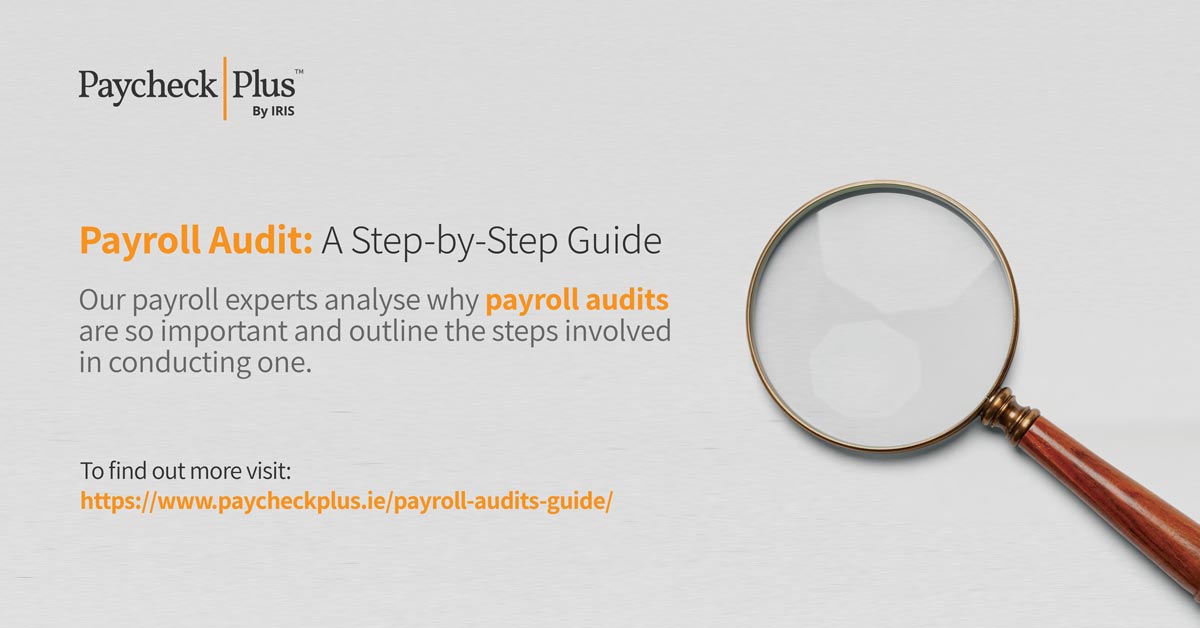
Payroll Audit: A Step-by-Step Guide
How to conduct a Payroll Audit
Why do I need a Payroll Audit?
Whether you are trying to ensure your payroll processes are accurate and compliant, or your organisation is preparing for an inspection from a regulatory body such as Revenue or the Workplace Relations Commission, most organisations should frequently conduct a Payroll Audit.
When correctly administered a payroll audit is an effective way to make sure that payroll is being processed in a proficient way that satisfies your legal and financial responsibilities whilst also meeting employee expectations.
Performing a payroll audit gives you peace of mind that your business is processing payroll correctly and in accordance with all legislative, regulatory, and contractual requirements while also detecting any potential hazzards in the payroll process. This will help you identify ways to improve the efficiency of your payroll service and strengthen your organisation’s financial controls.

What is involved in a Payroll Audit?
Step 1: Identify and Verify the Number of Active Employees
The first stage of any payroll audit is to identify and verify the number of active employees. To do so, you must consider those who have left the company since the last pay run, those who have joined the company, and those who have been temporarily subject to exemptions or payroll changes.
In the case of leavers, a payroll audit would determine whether the correct leave date has been entered onto the payroll processing system, whether PRSI (Pay Related Social Insurance) Weeks and other payslip information has been pro-rated, whether accrued annual leave entitlement has been accounted for, and where the employee is involved in other schemes (such as travel), that accurate balances have been captured in the final payroll payment. In larger companies, it is not unusual for recent leavers to remain on the company ledger following their departure, and it is important to identify these oversights before processing payroll to avoid making unnecessary payments to inactive employees.
The payroll audit should also review the onboarding process for new employees and ensure that the correct information has been entered onto the payroll processing system. For example, correct and full bank details should be obtained to ensure that there is no delay in receiving payment, and PRSI Weeks should be pro-rated. Backpay (where applicable) should be processed, and in the case of public sector employees, the correct Additional Superannuation Contribution (ASC) Classification, Basis and Scheme applied.
Finally, the payroll audit should consider employees who may be out of the business on a temporary basis perhaps through maternity, paternity, adoption, or sick leave. The impact of these temporary considerations on current and future payrolls should be accounted for and documented.
To complete these checks effectively, the auditor will require access to contracts of employment or the information continued therein. As this is typically confidential and sensitive information which you may not wish to share with employees outside of the HR department, many organisations prefer to outsource this function to an external payroll audit service, such as Paycheck Plus. By utilising a discreet outsourced payroll service, the risk of confidential salary and benefits information being shared with unauthorised staff is minimised.
Step 2: Verify Correct Payments
Once the payroll audit has established the ‘active employees’ requiring payment, it then needs to verify that each employee is being paid the correct rate, and that any benefits or deductions have been correctly configured on the payroll system and implemented.
The method of verifying payment rates will depend on the type of payment; where an employee is paid on an hourly basis, the payroll audit should confirm both the hourly rate (from the employment contract) and the number of hours worked during the payroll period (according to the time card or clock). Where the employee is salaried, the payroll audit should compare the amount paid with the salary detailed on the employment contract. Overtime, sick pay, annual leave, pay rises and other anomalies should also be considered, and verified.
The payroll audit should also cover additional employee benefits and deductions; for example ensuring that employees have been assigned to the correct pension plan, that benefit in kind data has been set up correctly, that the correct PRSI class has been assigned, and that payroll and allowance information has been entered onto the system and is correct when compared to the employment contract.
In the case of large organisations with several hundred employees, a good payroll audit will verify employee rates, benefits and deductions on a representative cross-section of records, selecting different criteria on each audit to ensure that, over the course of several months, most if not all records have been audited.
Step 3: Operational Checks
Once the payroll audit has considered payment inaccuracies, the payroll process itself should be audited to ensure that it remains fit for purpose, efficient, and compliant.
From an operational perspective, this means ensuring that all administrative tasks have been completed properly. A good payroll audit will review the filing systems in place and will consider whether they are sufficient to facilitate fast retrieval of information whilst also maintaining data security at all times. The auditor will also look at how payroll queries have been addressed and resolved, and specifically the documentation and audit trails relating to these. A payroll audit will review whether employee preferences have been considered, both in terms of communication (i.e., by email or post) and payslips (set to ‘email’ or ‘print’). Finally, a payroll audit will look at manual calculations that may have formed part of the payroll process, checking that these have been calculated correctly and validating any related figures.
Step 4: Checking Payroll Reports and Reviewing Bank Reconciliations
Having checked the employee-facing elements of the payroll process, a good payroll audit will then consider the internal allocation of the payments to ensure that they have been correctly accounted for.
Specifically, the audit will check the journals raised as part of the payroll process (including those relating to pension contributions and PAYE) and check that these can be reconciled against the related bank payments. The audit is also likely to consider the payment approval process, to ensure that the correct authorisations were obtained and documented.
Step 5: Ensuring Regulatory Compliance
One of the most important parts of any payroll audit is checking that the information reported to regulatory authorities (such as Revenue) is comprehensive and accurate. Poor compliance can lead to external audit, financial penalties, and in the most serious cases, litigation.
To this end, a payroll audit must thoroughly review all tax submissions filed with Revenue to ensure that they are correct; it must review Revenue Payroll Notifications and tax codes to ensure that they have been downloaded and applied correctly. A payroll audit must check that Payroll Submission Requests (PSRs) have been submitted as per Revenue guidelines, that Revenue payments have been actioned where applicable, that the PAYE Liabilities Internal Reconciliation form has been updated, and that monthly statements have been reviewed, reconciled and accepted as per Revenue timelines.
Any discrepancies identified as part of this audit process must be investigated as a matter of urgency to ascertain whether the anomaly is an isolated error or the result of a systemic failure in the payroll process. In either case, consideration should be given to potential changes in the payroll process which may avoid this kind of error in the future.
Step 6: Analyse Results & Make Recommendations
Having explored each area of the payroll process, the final element of a payroll audit is to take stock of the audit’s findings, analyse the results and make recommendations – both in terms of how to improve current processes, and proactively develop new processes to become more efficient and achieve greater accuracy in the future.
It is at this stage of the audit where the multi-faceted experience of an outsourced payroll provider really pays dividends. It can be difficult for an internal auditor to look objectively upon the processes developed by their own department or colleagues, particularly where large-scale change is required. An external auditor such as Paycheck Plus can take a much more objective view, making recommendations that are unimpeded by internal bias. What’s more, the Paycheck Plus team has a breadth of knowledge and experience in terms of payroll audit and is more likely to be aware of best practice techniques implemented in other organisations that could assist your business. This specialist knowledge can fast-track your company’s payroll development and help you to achieve greater accuracy, compliance and efficiency in a much shorter timescale.
For more on improving your payroll security read:
Why Outsource Your Payroll Audit?
Outsourcing payroll audits and related payroll services to payroll companies such as Paycheck Plus is one of the most efficient ways to ensure compliance and accuracy in your payroll processing. With a professional team of international payroll specialists, Paycheck Plus have access to the latest and most secure payroll technology and infrastructure, allowing us to provide accurate and insightful payroll audits that enable international and domestic businesses to make evidence-based decisions about their payrolls.
At Paycheck Plus we provide comprehensive, ISO accredited, cost effective payroll outsourcing and payroll auditing services. Specialising in all aspects of payroll processing, our team of payroll service experts are well-versed in all payroll-related complexities and can cater to all of your payroll auditing and processing needs.



